Planting Bulbs for Forcing Indoors
Posted on Wednesday, October 27, 2021 · Leave a Comment
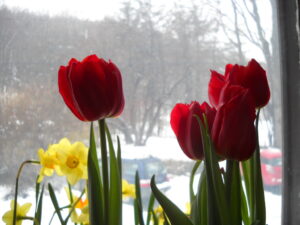
Forced tulips are my favorites
I love the winter, but by March I am ready for spring. I usually have some snowdrops blooming in March on a south-facing hillside, but they are subtle, not bodacious blooms. So I plant lots of bulbs indoors in the fall and keep them cool until it is time to bring them into the warmth of the house, and I get indoor tulips, daffodils and more in March. That’s what forcing bulbs is all about. It’s simple, really, but there are a few tips I can share since I do this every year.
Most bulbs are described on their packages as early, mid-season or late. Go to your local garden center and look for bulbs that are labeled as early bloomers – they are the best for forcing. Buy daffodils, some tulips and maybe some small bulbs like crocus or grape hyacinths. You can plant these bulbs in large pots or even in your window box if you bring it in.
You will also need some potting soil and compost. I make a mix that is half compost, half potting soil for forcing bulbs. I don’t use garden soil because it can be heavy and often stays wet. Bulbs can rot if they are left in wet soil for too long. I often reuse the potting mix that I used for growing annual plants outdoors in summer. I just pull up the summer’s plants, fluff up the soil, add some compost as needed, and make sure it is damp to start. If it is dry, I water it before I plant my bulbs.
Each year I plant about 25 daffodils in a window box that is about 30 inches long, 6 inches wide and deep. I prefer to get all of one kind so that they all bloom at once.
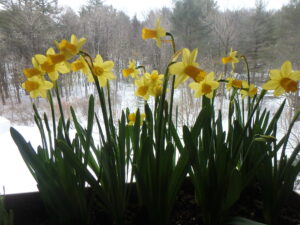
Tete a tete daffodils forced to bloom on a windowsill
I fill the window box a little more than half full with my mixture of compost and potting soil and place the bulbs, pointy end up, in the soil. Once I have them all in place I push them down more and fill up the box with more potting soil-compost mixture.
Be sure to label each pot with the date planted, and what is planted. Later, that will tell you when you can bring it into the warmth. Daffodils take about 12 weeks of dormancy before they should be brought into the warmth of the house, and tulips do better with 4 full months. Little things like crocus can be forced in 8 to 10 weeks.
Often bulbs will send roots out through the holes in the bottom of the pot or send up green shoots telling you they are ready. But don’t rush the process. Tulips brought up early will have nice green leaves, but no flowers.
Ideally temperatures for bulbs used for forcing will be between 32 and 50 degrees, though colder temperatures should not be a problem (my basement often goes below freezing for a few days). Left in a warm location, the bulbs will grow green tops – but not blossoms. Bulbs left in a cold basement or garage will do just fine. Inside the bulkhead to your cellar might be the right temperature, too.
You need to be aware that rodents like eating bulbs (indoors or out) – especially tulips. My basement has, most years, harbored mice and sometimes even a resident red squirrel. Unlike tulips, daffodils are not of interest to rodents as they are mildly poisonous. I keep my pots of tulips covered with hardware cloth (a fine-mesh metal screening available at hardware stores). But wear gloves if you cut hardware cloth to size – the edges are as sharp as razor wire.
You can double your production of blooms by planting two layers of bulbs in a container. Plant big bulbs deep in the pots, add soil, and then plant a layer of crocus or other small bulbs above them.
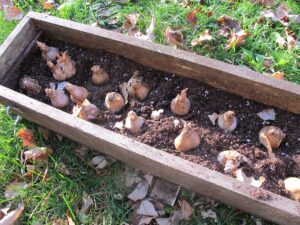
Daffodils being planted in a window box for forcing
It is important to check on the bulbs you are forcing at least once a month, particularly if you have put wire rodent-proofing over the containers. I’ve had shoots try to grow through the hardware cloth and get damaged. If the bulbs are sending up shoots, remove the wire mesh. I also don’t want the soil mix to get bone dry, so I check it and water a little if it’s dry. The bulbs will grow roots when first planted, and then go dormant if kept in a dark, cold location.
When it is time to bring up your potted bulbs into a warm place, let them wake up gently. My mudroom is good for starting them: there is some sunshine but it is cool. Then, once the shoots are up and green, I place the containers on my sunniest window sills – either east- or west-facing.
Most bulbs that have been forced are not likely to flower the following year, even if you keep the foliage alive until spring and plant them outside. I’ve done it, and some daffodils will build up the energy to blossom after a while, but tulips are not so cooperative.
I was a Peace Corps volunteer in Cameroon, West Africa many years ago. There I could have flowers blooming every day of the year. It spoiled me, perhaps, because I still want flowers every day. Forcing bulbs is one way to have lots of blossoms when there is snow on the ground. So don’t wait until mid-December to start your bulbs, get on this project now.
Henry is the author of 4 gardening books, and is a long time UNH Master Gardener. Reach him at PO Box 364, Cornish Flat, NH or
henry.homeyer@comcast.net.
Tips for Forcing Spring Bulbs Indoors
Posted on Sunday, November 4, 2018 · Leave a Comment
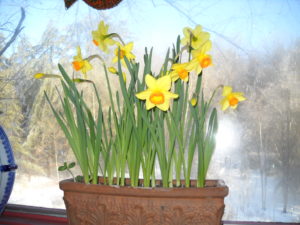
Forced daffodils
One of the easiest, and most satisfying, gardening activities I do each year is to plant tulips, daffodils, hyacinths and crocus in containers each fall. I keep them in a place that is cold, but not freezing, for 3 or 4 months, then bring them into the warmth of the house where I get gorgeous blossoms when snow may still be on the ground. I recently potted up a dozen containers with spring-blooming bulbs.
There are a few things you should know about forcing bulbs. First, you will need a cold dark place where you can store your bulbs after planting them in containers. Thirty-five to fifty degrees Fahrenheit is best, though if the temps go down below freezing for a while, that’s all right, too.
Second, it is important to select bulbs that are labeled “early” or “mid-season”, not “late-season”. It is important label each pot with the date you planted it so you can decide when to bring it into the warmth of the house. If you bring in tulips too early you will get leaves, but not blossoms. Always wait 4 months for tulips to be ready.
Daffodils only need to rest for 3 months before you bring them into the house. The smaller bulbs will do fine with even less. You will see the noses of snowdrops or crocus pop up out of the planting mix, begging for some sunshine so they can bloom.
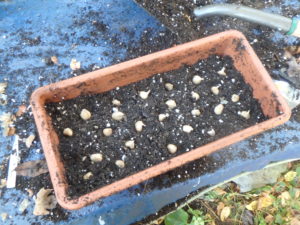
Small bulbs can be planted close together
Planting bulbs for forcing is easier than planting them outdoors. All you need are a few appropriate containers and some potting mix. I use my window box each year, forcing 25 daffodils in a box roughly 36 inches long, 7 inches deep and 7 inches from front to back. It has holes drilled in the bottom for drainage, which is important – no bulb likes soggy, poorly drained soil.
When preparing any container for planting, fill it about half way up with a good potting soil. Or you can mix the potting soil with compost to make a 50-50 mix. Or you can make your own potting mix using peat moss, compost and perlite or vermiculite.
Perlite is the white stuff you often see in commercial potting mixes – it looks like Styrofoam. But it is actually an expanded mineral that has been heated until the moisture inside it makes it pop like popcorn. It is great for keeping soil mixes lightweight and holds air, which is important for roots. Vermiculite is another expanded mineral – this one from mica. It is lightweight, but holds water.

Daffodils planted in a window box for forcing
The soil mix you use should never be allowed to dry out completely when forcing bulbs. This means you need to check on the pots once a month. If the soil mix is dry, you need to water lightly. I like to start with a mix that is quite moist when I plant the bulbs. If you use bagged peat moss in making a mix, be sure to moisten it a few days in advance. Peat moss does not quickly absorb water when it is fully dry.
So you have your pot half full of potting mix. How many bulbs can you fit into the pots? I often use rectangular clay pots that are a foot long and 5 inches deep and from front to back. If using small bulbs like crocus, I plant 20 or 25. For larger bulbs like daffodils or tulips I plant 10 or 12 in the same size pot. In a round 8-inch pot I planted 3 hyacinths this year. I plant bulbs closer in a pot than I would outdoors.
Once planted, cover the bulbs with your potting mix and pat the soil with your hands to firm it up around the bulbs. Then give the pots a light watering and place in a cool place, as described above.
If you don’t have a cold basement, you might place them in a garage or even on the steps coming up outdoors from your basement. Just remember that they must develop roots and start growing in a cold, not freezing location.
Depending where you store your bulbs, mice or squirrels will eat tulips and other bulbs indoors just as greedily indoors as out. And I’ve even had them dig daffodils out of pots and leave them in disgust –they must wonder who would want to eat them.
The easiest solution to the rodent problem is to cover each container with a piece of plywood cut to the size of the container. Just be sure to check the containers often, come spring. I’ve had bulbs start growing, hit the plywood and get all bent over.
To maximize the number of blooms you get, you can plant two layers of bulbs. Plant crocus or other small bulbs over daffodils or tulips. Just cover the bigger bulbs with soil mix, then add the small bulbs and cover them. It can be quite dramatic. I have done this outside, too.
By mid-winter I am aching to see blossoms. Since I won’t be seeing them outside, I love to have them inside. If you have had trouble with animals eating your tulips, forcing bulbs indoors is a good way to enjoy them – without fear of squirrels digging them up or deer eating the flowers. Plant them now, or certainly by mid-December, and enjoy them in early spring.
Henry can be reached at henry.homeyer@comcast.net. He is the author of 4 gardening books.
Potted Bulb Plants
Posted on Wednesday, February 24, 2016 · Leave a Comment
As we amble toward spring I find I crave blossoms more and more. This must delight the people who sell flowers, as I have a hard time walking by a display of iris or daffodils growing in pots without buying some. But buying grocery store potted bulb-flowers is not just an indulgence. Many can be kept alive until the ground thaws and planted. Others are less durable. Let’s take a look.
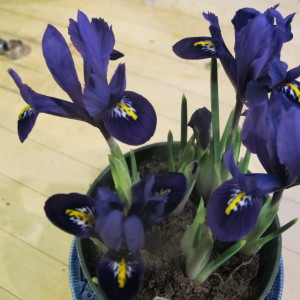
Iris reticulata
I love those little purple iris that are commonly sold in 4-inch pots. I bought some recently for $3.99 and although they only lasted a week, I was delighted to have them. This particular iris is known to botanists by its Latin name, Iris reticulata. It’s related to Siberian iris and bearded iris, but has different growing needs.
According to the tag that came with the iris, you can plant these outdoors “in part shade after last spring frost.” What they don’t tell you is that Iris reticulata require very good drainage. They originated in the mountains of western Asia where they grow wild on pumice slopes of extinct volcanoes.
If you want these fabulous little iris to succeed for you, do not plant them in a heavy clay soil. In fact, build a six-inch raised bed of sandy soil and grit with very little organic matter. Outline your planting bed with stones or bricks. You should be able to pour water from your watering can over the bed and not have any pooling. Planting on a hillside will help with drainage, too. Most of my soil is too rich for Iris reticulata, so I’ve not had good luck with them after the first year. I guess this year I’ll build them their own little bed.
Tete-a-tete daffodils are great little bundles of yellow joy that are common in grocery stores and at flower shows. Each bulb produces more than one mini daffodil. They are very cold hardy and can be planted outdoors when the soil has thawed. Just keep them watered indoors after blooming. Like other small bulbs, plant the tips just 2 inches beneath the soil surface.
Every year I force paper whites. Also in the daffodil family, these are not usually planted in soil indoors, but in a container filled with pebbles. Choose one that has no holes and arrange the paper whites bulbs among the stones. Later, when the leaves and stems are tall, they will tip over unless you arrange your stones so that they hold the bulbs in place. I add water until it just kisses the bottom of the bulbs. Roots emerge and soon thereafter green leaves and flower buds emerge. Each bulb should produce more than one blossom.
The paper white flowers are usually – though not always – highly fragrant. Some people do not like the scent, though I do. And even after the flowers have dried out they still look good to me for quite a while. The unfortunate part about paperwhites is that they are not viable in our climate outdoors. No, do not save them and plant outdoors. They will not come back for you next year.
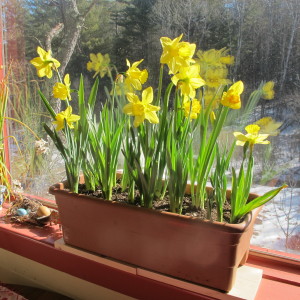
Forced daffodils in Earth Box
I also potted bulbs for forcing that I put in my cold basement last November, and I have brought them up into the light and warmth of the house. This year I used a plastic container called an “Earth Box” for planting. The one I used is 22 inches long, 9 inches wide and has a planting space about 7 inches deep; I planted about 20 bulbs in it. It is a “self-watering container” that has a water holding compartment a couple of inches deep.
Self-watering containers are all the rage for growing flowers on decks and doorsteps. They prevent the dehydration (and death) that old fashioned flower pots allowed. They wick up water from the water reservoir so that you only have to water once a week or so, depending on the weather. But they are great as containers for bulbs, too, because they don’t leak water out onto your table or windowsill unless you dump gallons of water and make them overflow.
Tulips are some of my favorite flowers but are also loved by deer, chipmunks, voles (but never moles), red squirrels, gray squirrels and a variety of other rodents. The bulbs are even edible by humans – some Dutch ate them to avoid starvation in WWII. So most years I plant some in pots and force them to bloom indoors. Just enjoy them now.
My personal experience is that tulips bloom well their first year –indoors or out – but fewer and fewer bloom each year thereafter. So if you buy potted tulips at the florist shop or nursery, I don’t think they are worth babying along until summer and planting outdoors in May.
I planted 100 tulips in a big raised bed in my vegetable garden last fall. I planted a few garlic cloves in with them in an effort to discourage rodents, though that is no sure cure. In the past deer have not bothered my tulips, but if I am feeling paranoid or see lots of footprints near the tulip bed, I could surround it with a chicken wire fence. Since the bed is only 8 feet by 3 feet, even a 4-foot fence should keep out the deer, I believe. I will use the tulips as cut flowers.
So brighten your house with some flowers grown from bulbs. Most you’ll be able to plant outdoors for another show next year, albeit later.
Henry may be reached by e-mail at henry.homeyer@comcast.net or at P.O. Box 364, Cornish Flat, NH 03746. Please include a stamped envelope if you wish a response by mail.
Forcing Bulbs
Posted on Wednesday, November 19, 2014 · Leave a Comment
I love to ski and snowshoe. I don’t mind shoveling snow and lugging in firewood for the woodstove the chugs along day and night now. But there are limits to my patience, and by March I’ll ready for green growing things and some fresh flowers. So I start lots of veggies and flowers by seed, starting in March and April. But I also force bulbs to bloom indoors in March. Now is the time to do so.
Most bulbs are described on their packages as early, mid-season or late. Go to your local garden center and ask for bulbs that are early bloomers because they are the best for forcing. Buy daffodils, some tulips and maybe some small bulbs like crocus or snowdrops. You can plant these bulbs in large pots or even in your window box that is, by now, cleaned out and stored in the garage or barn.
You will also need some potting soil and compost. I make a mix that is half compost, half potting soil for forcing bulbs. I don’t use garden soil because it can be heavy and often stays wet. Bulbs can rot if they are left in wet soil for too long.
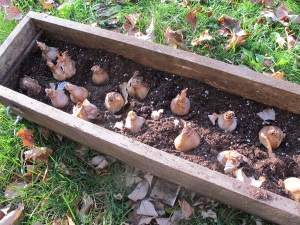
daffodils being planted for forcing
I recently planted 25 daffodils in a window box that is about 30 inches long, 6 inches wide and deep. It was a mix of different kinds of daffodils. I prefer to get all of one kind so that they all bloom at once, but the mixed bag was what was available (and on sale).
I filled the window box a little more than half full with my mixture of compost and potting soil and placed the bulbs, pointy end up, in the soil. Once I had them all in place I pushed them down more and filled up the box with more potting soil-compost mixture. Bulbs for forcing can be planted shoulder to shoulder, or nearly so.
In order to prepare bulbs for early blooming indoors, you will need a place to store them that is cold, but not as cold as the outdoors. Despite global warming, I still see minus 20 every winter, even if for only a few days. Bulbs planted in the ground have some protection against the cold, but if you were to plant bulbs in pots and leave them outside, the extreme temperatures would kill most. Bulbs left in a cool basement or garage will do just fine. Inside the bulkhead to your cellar might be the right temperature, too.
Ideally temperatures for bulbs used for forcing will be between 25 and 50 degrees, though colder temperatures should not be a problem (my basement often goes below freezing). Left in a warm location, the bulbs will grow green tops – but not blossoms.
You need to be aware that rodents like eating bulbs (indoors or out) – especially tulips. My basement has, most years, harbored mice and even sometimes red squirrels. In fact, I have learned the hard way that indoor rodents can – and will – dig up and eat tulips. So now I keep my pots of tulips covered with hardware cloth (a fine-mesh metal screening available at hardware stores). But wear gloves if you cut hardware cloth to size – the edges are as sharp as razor wire. Daffodils, on the other hand are not of interest to rodents as they are mildly poisonous.
You can double your production of blooms by planting two layers of bulbs in a container. Plant big bulbs deep in the pots, add soil, and then plant a layer of crocus or other small bulbs above them. To avoid planting the little guys right over the big boys, you can mark the location of the deeper bulbs with straw from a broom. That way they won’t get pushed over as the daffodils come up. Or you can just take your chances.
Don’t wait until mid-December to start your bulbs, get on this project now. Daffodils take about 12 weeks of dormancy before they should be brought into the warmth of the house, and tulips do better with 4 full months. Planted now, they would be ready in mid-March. Little things like crocus can be forced in 8 to 10 weeks.
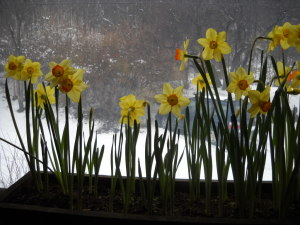
Forced flowers
It is important to check on the bulbs you are forcing at least once a month, particularly if you have put wire rodent-proofing over the containers. I’ve had shoots get damaged by trying to grow through the hardware cloth. If the bulbs are sending up shoots, remove the wire mesh. I also don’t want the soil mix to get bone dry, so I check it and water a little if it is too dry. The bulbs will grow roots when first planted, and then go dormant if kept in a dark, cold location.
When it is time to bring up your potted bulbs into a warm place, let them wake up gently. My mudroom is good for starting them: there is some sunshine but it is cool. Then, once the shoots are up and green, I place the containers on my sunniest window sills – either east or west facing.
I was a Peace Corps volunteer in Cameroon, West Africa many years ago. There I could have flowers blooming outside every day of the year. It spoiled me, perhaps, because I still want flowers every day. Forcing bulbs is one way to have lots of blossoms when there is still snow on the ground.
Henry Homeyer is the author of 4 gardening books. His Web site is www.Gardening-Guy.com. You may also reach him by e-mail at henry.homeyer@comcast.net.
Preparing Bulbs for Forcing
Posted on Wednesday, November 6, 2013 · Leave a Comment
Winters here can be long and cold. Sometimes they are burdensome for a guy like me who loves being outside playing in the garden – planting and picking flowers, or harvesting lettuce and berries. But like the squirrels, I’m planning ahead and burying some little round things for future enjoyment. Nuts? No, I’m not. I am planting bulbs in pots now so they will bloom indoors in February and March.
Each fall in early November I plant tulips and daffodils and sometimes crocus in pots, planters, and in a window box that I take down and bring into the basement where it’s cool and dark. Almost any spring bulb can be planted for forcing, and now is the time to do it.
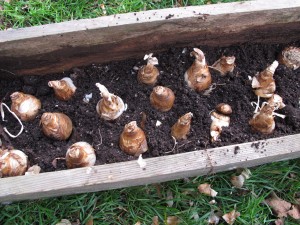
Daffodils for forcing
One nice thing about forcing bulbs is that the deer cannot get them. Tulips are like magnets for deer and rodents in many neighborhoods, though my fierce and determined Corgi, Daphne, does a pretty good job of deterring them for me. But tulips growing inside are unlikely to be bothered by anything. That said, one year rodents did get in my basement and dug up tulips that were in pots, so I sometimes cover containers of tulips with wire screening I get at the hardware store called hardware cloth.
My window box is one I built over 10 years ago out of cedar and it is still holding up nicely. (A nice winter project might be to make one yourself. Directions are in my first book, Notes from the Garden, which is now out of print but available at many libraries.) The box is 36 inches long and 7inches deep and 9 inches from front to back.
Outdoors I plant tulips and daffodils so that their tips are six inches below soil surface, and 2 to 3 inches apart. But in my window box I plant them closer together to cram as many bulbs as possible in the space given. I plant them in 2 inches of soil mix so that they have plenty of space for their roots, but this means their tips are just below the surface of the planting medium after I fill up the box.
I start the process by dumping out all the plants and soil from my window box. I take a stiff scrub brush (the one I use for cleaning out garbage cans) and clean the window box as often roots and dirt are sticking to it. I have drilled holes in the bottom of the box for drainage and I check to see that they’re not clogged.
Garden soil is great for growing bulbs outdoors but is not ideal in a container. In a pot it tends to get compacted by watering. So I make a mix that is 50% compost and 50% potting mix that I buy. That mix is very light and fluffy because it contains peat moss and perlite. Perlite is an expanded mineral – sort of a rock popcorn. It’s the white stuff that looks like Styrofoam in potting mixes.
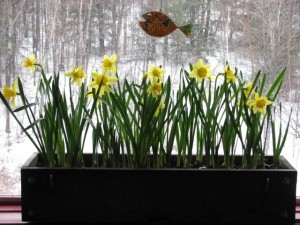
Forced Daffodils
I planted 25 large daffodils in my window box, which was a bit of a squeeze, but will be dramatic when they bloom. Some years I plant 2 or 3 varieties of daffodils in it to stagger the bloom time, but this year I went for the “Big Bang” look – all blooming at once. I will bring the box out of the cold basement in early March.
After planting I water the mix lightly if it is dry. Bulbs won’t do well if sitting in soggy planting mix, but they also are living beings that are growing roots and that need some moisture. If the soil mix dries out too much, I sometimes do a light watering half way through their winter rest.
When selecting bulbs for forcing, “early-season” varieties are best. Some varieties will be listed as “good for forcing” and those are ideal. Daffodils I give a minimum of 90 days of rest before bringing them into a warm room to start the process of above-ground growth. Tulips I recommend 120 days – 4 months from now is mid-March. If you bring them up without proper rest, you will get foliage but no blossoms. Crocus are ready in 10 weeks or so, but can be planted in the same container as daffodils – as a second layer of bulbs above the daffodils.
Those 8-inch plastic pots that are used for perennials at the garden center make good pots for forcing, too. Half a dozen tulips in one will make a very nice display indoors while there is still snow on the ground. Plant several pots and bring one into the warmth every week for a continuous display.
Oh yes, temperature is important, too. The ideal temperature for forcing bulbs is 40-45 degrees. Anything over 50 is too warm, and below freezing is too cold. You might have a place in your garage or on the steps of the bulkhead, or even in an unheated mudroom. It is best to keep the pots in the dark, but you can create that by placing a plank over the top, I suppose.
So go get some bulbs and pot them up for a late winter delight. It’s easy, it’s not costly, and you can plant those bulbs in your garden after they have done their work – cheering you up.
Henry Homeyer is the author of 4 gardening books and a fantasy-adventure for children, Wobar and the Quest for the Magic Calumet. His Web sites are www.henryhomeyer.com and www.Gardening-Guy.com.
Forcing Bulbs for Spring
Posted on Wednesday, October 31, 2012 · Leave a Comment
Winters can be hard on many gardeners: short dark days, icy roads and little to do in the garden. Yes, I like to snow shoe and cross country ski, but it doesn’t replace gardening. I water my houseplants (and occasionally talk to them), but they are weak substitutes for the real thing. By the time mud season comes in March, I want blooming flowers to brighten my life.
I get early blossoms in two ways: First, I have early bulb plants outdoors, including hundreds of snowdrops that bloom in March. And second, I force bulbs to bloom early indoors. Now is the time to plant bulbs so that they will bloom when we need them the most – a month or two before they bloom outdoors.
In order to prepare bulbs for early blooming indoors, you will need a place to store them that is cold, but not as cold as the outdoors. Despite global warming, I still see minus 20 every winter, even if for only a few days. Bulbs planted in the ground have some protection against the cold, but if you were to plant bulbs in pots and leave them outside, the extreme temperatures would kill most. Bulbs left in a cool basement or garage will do just fine.
Ideally temperatures for bulbs used for forcing will be between 33 and 50, though a few days of below freezing temperatures is not be a problem (my basement often goes a below freezing). Left in a warm location, the bulbs will grow green tops – but not blossoms.
Bulbs can be planted for forcing in pots or window boxes. Good drainage is important to avoid rotting the bulbs, so don’t plant them in ordinary garden soil. I think an ideal mix is one that has half compost and half potting mix. I want the mix to be lightly moist at planting time, but not soggy. Once a month I check the pots to make sure the soil is not bone dry; if it is, I water lightly.
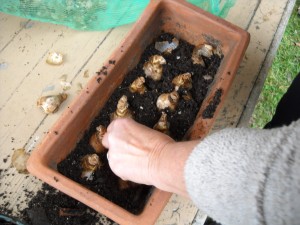
Forcing Bulbs
When planting daffodils or tulips outdoors, I plant them 6-8 inches deep but that is not necessary when planting bulbs in pots. Depending on the type of container I use, the pointy tips of my bulbs may be just an inch or two below the soil surface. And I plant them shoulder-to-shoulder, crowding in as many bulbs as possible in the container. After they finish blooming in the spring I will plant the bulbs outside, but for now they have everything they need to bloom inside the house.
Timing is key to success with forced bulbs. Little bulbs like crocus need just 8-10 weeks of dormancy, but daffodils need 12 weeks, and tulips do better with more, up to 16 weeks. Choose bulbs that are marked “Good for Forcing” or that are listed as “early” rather than mid-season or late. If you are selecting bulbs now, make sure that they are still firm, not papery and dried out. And if you see them with long green sprouts, pass them by.
Beware of mice. If you have mice, they will eat your tulips unless you exclude them somehow – with wire mesh screening, for example. Daffodils are lightly poisonous, so mice don’t eat them.
You can maximize blooming by planting two layers of bulbs. I often use those 8-inch pots that perennials come in for forcing. They are not elegant, but can be dressed up with wrapping paper or baskets when displayed on the table. I put in an inch of gravel, an inch or two of soil mix, then daffodils or tulips. I cover them with soil, and then add a second layer of bulbs. The small bulbs like crocus work well for a second layer. Leave a little space at the top of the pot for watering.
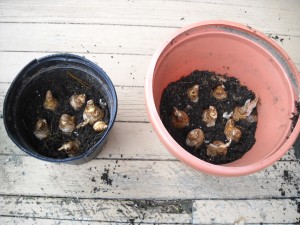
Forcing Bulbs
When planting two layers of bulbs I used to worry about the big bulbs coming up and pushing the little ones aside like playground bullies. So I carefully placed the little ones above the spaces between daffodils. I even used broom straws to show me where to plant. But one year I just put them in without worrying about crowding and every bulb did fine. Plants know more than we give them credit for, I think.
When you take your plants out of their cold resting spot, most will begin to grow almost immediately. I generally start mine off in a cool location in the house, and once they have fully woken up I put them on a sunny, warm windowsill. A trick for prolonging their blooms (which also works with cut flowers from the florist) is to move the flowers into a cold mudroom or entryway at night. Cool temperatures prolong the life of your flowers.
So go to your local feed-and-grain store, garden center or food coop; get some bulbs and prepare them for forcing. Come March you’ll be ready for spring, and will have some flowers ready to perform their annual dance before their cousins outside do.
Henry Homeyer has a new children’s chapter book that just came out: Wobar and the Quest for the Magic Calumet. Read about it at www.henryhomeyer.com.
Forcing Bulbs – Now is the Time to Prepare for Early Spring Blooms
Posted on Thursday, November 17, 2011 · Leave a Comment
Winter came early to Cornish Flat this year with a heavy snow in late October. I love the snow and cold, but don’t need six months of it – which could happen this year if we have snow from October till April. I am, after all, a gardening guy. I love flowers and fresh vegetables from the garden. One of the things I do to keep my spirits up is to plan for those late winter blues, the time when winter seems endless. I plant bulbs in pots each November, forcing them to bloom indoors before Mother Nature would tell them to bloom outside. I recommend it.

Forcing bulbs for winter
Forcing bulbs is easier, by far, than planting spring bulbs outdoors (there is no digging required), and you are almost certain to succeed – they are safe from predation by deer, and can easily be protected from any rodents that might be looking for a winter snack. I store my pots with bulbs for forcing in a cold cellar, one that has, on occasion, harbored mice and even red squirrels. In fact, I have learned the hard way that indoor rodents can – and will – dig up and eat bulbs – indoors or out. So now I keep my pots covered with hardware cloth (a fine-mesh metal screening available at hardware stores). But wear gloves if you cut hardware cloth to size – the edges are as sharp as razor wire.
Your first job, if you wish to force bulbs to bloom indoors next spring, is to select those that are early bloomers. Each bulb contains the information needed to decide when to bloom. You can affect that timing, but choose packets of bulbs that say “early bloomer” rather than late. I need blossoms in March, not May.
Next, select containers that will accommodate ten or more bulbs. I have some nice Italian terra cotta containers that are about 14 inches long, 7 inches wide and 6 inches deep. For daffodils or tulips, they are right for about a dozen bulbs because I plant the bulbs pretty much shoulder-to-shoulder. I don’t leave much space between bulbs the way I would if planting outside. My favorite container for forcing, however, is my cedar window box that is 3 feet long and 9 inches wide. I fill it with 30 or more daffodils each fall, and come spring it is glorious.
For the planting medium, I use a 50-50 mix of commercial potting soil and my own compost. Garden soil generally is not a good choice – it can hold too much water , which can lead to bulb rot. I put a couple of inches of planting mix in the bottom of my container, and then arrange the bulbs. I cover the bulbs with more mix, pat the surface with a hand, and if the soil mix is dry, I water lightly.
You can double your production of blooms by planting two layers of bulbs in a container. Plant big bulbs deep in the pots, add soil, and then plant a layer of crocus or other small bulbs above them. To avoid planting the little guys right over the big boys, you can mark the location of the deeper bulbs with straw from a broom. That way they won’t get pushed over as the daffodils come up.
Planted now, bulbs will extend their roots and get them well established, and then they should go dormant. To achieve dormancy, you need a cold, dark location for the container. But not too cold. You can’t leave them outside or the bulbs will be ruined. Bulbs planted in the ground never get extremely cold – they are insulated against the cold by soil and snow (unlike those put on your deck, for example). One winter, as an experiment, I shoveled the snow off a section of my vegetable garden and dug into the soil. Using a temperature probe I learned that in a winter with plenty of snow, the soil was about 35 degrees just three inches down.
I recently received several e-mail inquiries about where to store containers of bulbs for forcing. If you don’t have a cold basement, do you have an unheated mudroom or a cold attic? An attached, unheated garage might do – basically any space that gets below freezing, but not much below is good. If you have a bulkhead that is closed off to the basement it probably stays cold enough. If temperatures get much colder than 20 degrees you risk damage to some bulbs.
The time a bulb needs to be dormant varies. Tulips need at least 12 weeks, though early daffodils and most small early bulbs – crocus, snowdrops, scilla – only need 8 weeks. Years when I plant bulbs for forcing early in the fall I often leave them for sixteen weeks. If you bring your bulbs up into the warmth of the house too early they will send up greenery, but may not bloom.
To get your bulbs to bloom, bring them into the warmth of the house and water lightly. Once their little green noses appear, put the containers in a sunny window and they will perform. I rotate the containers every few days, as the stems may lean toward the sun.
Winter can be oppressive for gardeners. Getting bulbs ready for indoor blooming in mud-season is cheaper than flying to the tropics – though I’ve been known to do that, too!
Henry Homeyer can be reached at P.O. Box 364, Cornish Flat, NH 03746 or henry.homeyer@comcast.net. His Web site is www.Gardening-Guy.com

















